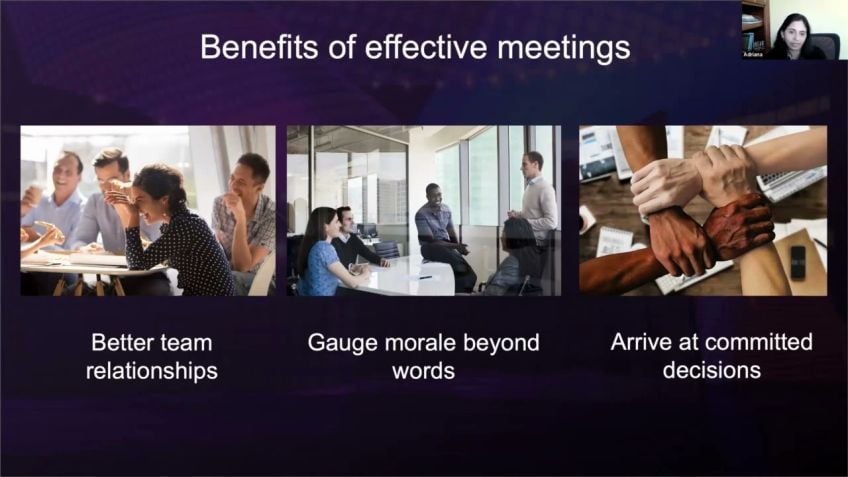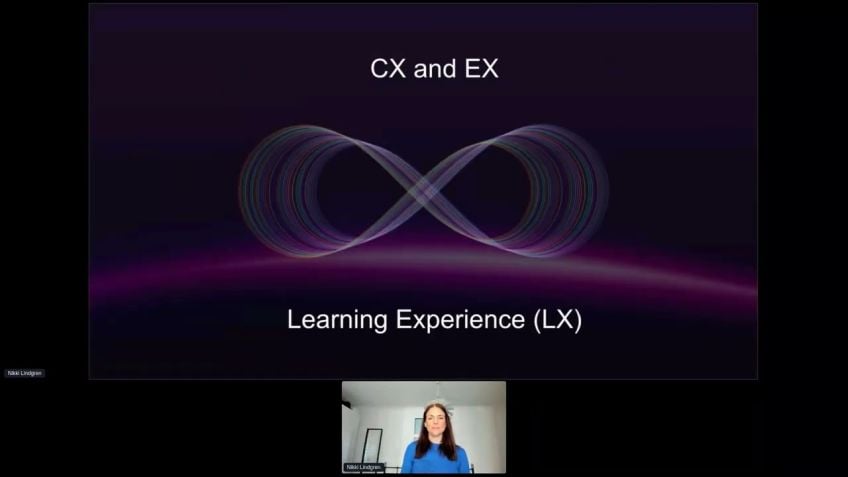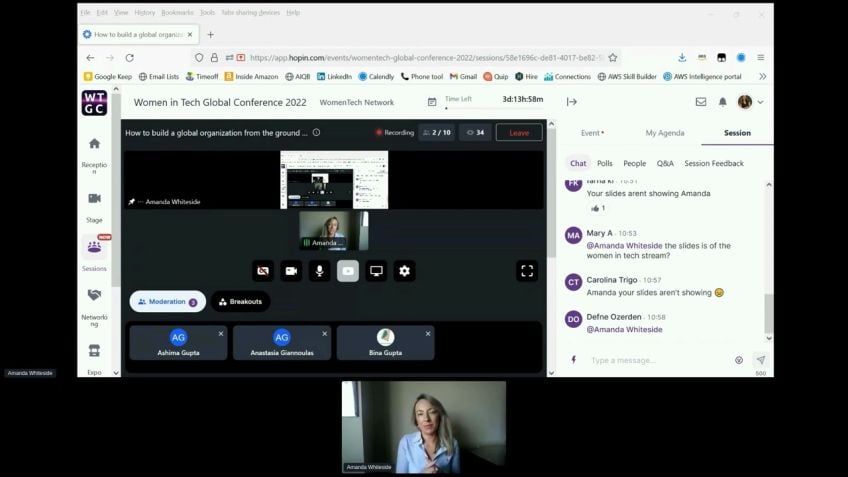Fueling with Failure by Alyssa Cox
Boosting Productivity: Learning from Failure
Hi, my name is Alyssa Cox, the founder of Blue Swift Consulting. Here, I'll take you through the critical impact of minor behavior tweaks on productivity and effectiveness in organizations. But today, our main focus will be the concept of 'fueling with failure'.
Exploring Failure: A Catalyst for Progress
"If you're not failing, you're not trying anything", a quote often credited to Woody Allen, echoes a widespread belief. We often perceive failure as an inevitable outcome of attempting new things — a stepping stone on our journey to success. Despite agreeing with this theory, most of us dread experiencing failure. Hiding behind our achievements, we rarely discuss our failures even though they provide the most significant learning opportunities for growth.
Consider my personal experience at a major consultancy — often, despite giving our best, some projects end catastrophically. It was difficult acknowledging and talking about such experiences. But if this sounds relatable, do remember, you are not alone.
The Tremendous Potential of Learning from Failure
Healthy participation in the process of identifying, acknowledging, and learning from our shortcomings allows us to grow individually. In 2021, employees received 64 hours of formal training, a significant jump from just 39 hours a decade ago. Much as investing in new skills is vital, if it makes up your entire learning approach, you might be missing out.
By overlooking the vital practice of learning from failure, you risk missing the opportunity to address and correct the root causes of these failures. These un-checked issues might drive potential failures in the future.
Distinguishing Risk-Inclined and Risk-Averse Organizations
Your organization's approach to learning from failure can reveal a lot about its culture and attitude towards risk. Let's explore the concept of risk-inclined and risk-averse organizations:
In a Risk-inclined organization
- Employees are encouraged to innovate, push their comfort zones, and take risks, even if they might not always lead to success
- Failures are perceived as opportunities for improvement, rather than reasons for punishment
- Learning from failure becomes an everyday routine, allowing employees to consistently enhance their delivery standards
Examples of this include Google's X Moonshot Innovation arm, which hosts annual celebrations of failed projects, and Pixar, which incorporates candor into its creative process. These are places where failed attempts are recognized and appreciated.
In a risk-averse organization
- Success is celebrated, but failure is penalized
- Employees are incentivized to cover up their mistakes and stay in their comfort zone, leading to a culture of blame and stagnation
- A McKinsey study reports over 90% of executives prefer avoiding potential losses to pursuing potential gains
On the other hand, risk-averse organizations often breed a culture of blame rather than innovation, with employees likely to self-censor ideas and avoid reporting errors to evade potential repercussions. This avoidance, while believed to be safer for careers, is detrimental to the organization's overall growth.
Transforming a Risk-Averse Culture
Although the appeal of a risk-inclined culture seems evident, the deeply entrenched habits of risk-averse organizations are challenging to break. Transitioning towards a more positive and open culture necessitates increased transparency and a management style that focuses on problem resolution rather than blame.
To steer your team in the right direction, consider the following practices:
- Encourage transparency and openness regarding failures.
- Transform retrospective analysis into productive steps for the future.
- Facilitate conversations about lessons learnt from past mistakes.
Remember: Don't hide a dead fish in your desk. Problems only worsen when ignored. It's best to address issues promptly so that they can be remedied, avoiding future mistakes. After all, failures are inevitable when attempting difficult tasks, and these difficult tasks lead to breakthroughs.
Thank you for joining me in this insightful session on 'fueling with failure.' Don't hesitate to reach out to Blue Swift if you have any questions or queries. Enjoy the rest of the conference!
Video Transcription
Thank you for joining me for this lightning session. My name is Alyssa Cox. I'm the founder of Blue Swift Consulting, where we help organizations and individuals unlock productivity and effectiveness by identifying small tweaks in people's behavior that make a big difference.
And today we're here to talk about fueling with failure. If you're not failing, you're not trying anything, look it up. This quote is commonly attributed to Woody Allen, but you can find similar quotes from a whole slew of influential people. We all seem to agree in theory that failure in one form or another is an inevitable outcome of trying new and worthwhile things, something to identify, acknowledge and build upon on our path to bigger and better. But is that really our experience in the real world? I spent a good part of my career working for a major consultancy. And one of the things we did really well was talking about all the stuff we were great at and then we get on the ground and we do our best, but you can't control everything and sometimes things didn't go so hot. I was on one particular project that was really very challenging and by many measures and abysmal failure. Now I learned a ton and actually, I'm really proud of the work that my team and I did. But afterwards I found that we had a really hard time talking about those two years on that project as part of my career journey. Now, if that scenario sounds even the least bit familiar, you should know that you're in good company.
I'd say if you haven't experienced at least one thing that could have gone better today, then it's either very, very early in the morning or you've cracked the code on thinking in a productive way about things that didn't go as well as you might have hoped. And that's what we're here to talk about today, identifying, acknowledging and building on things that didn't go as well as they might have both. So you can learn, but also so others can learn from you. Because our ability to do that is really transformative in terms of how we're able to grow individually. In 2021 the average employee received nearly 64 hours of formal either online or in person training over the course of the year. And that's compared to just 39 hours 10 years ago. Investing in new skills and concepts is certainly necessary to help your team keep up with changes in the business environment. But if it makes up the sum in total of your approach to learning, you're missing a meaningful opportunity.
That's already built into the way you work and it's likely costing you more than you realize. And of course, I'm talking about the way we approach learning from failure. Learning from failure is our last best opportunity to drive value from things that didn't go the way we wanted them to. By not taking an intentional approach to learning from failure, we not only lose out on the opportunity to learn, but we also make it more likely that the root causes of failure go unmediated and drive future failures. In my experience, an organization's approach to learning from failure actually speaks volumes about its cultural disposition to risk. Remember the quote, if you're not failing, you're not trying anything in organizations where risk taking is encouraged, learning from failure is a frequent and collaborative experience.
And I call these risk inclined organizations here, employees are encouraged to innovate, try new things, push the limits of their comfort zone knowing that not every bet is gonna pay off and not every attempt will be a success and things do go counter to plan in these organizations.
Google X. Google's Moonshot Innovation arm holds annual celebrations to hear testimonials about failed projects and the spotlight failed prototypes. Pixar has institutionalized Candor into the creative process through its brain trust peer review process where directors and storytellers not involved in a project, review, early versions of a movie and provide constructive empathetic feedback and suggestions. They seek out failures in the project as opportunities to fix them rather than to punish. Because risk inclined organizations celebrate people for taking chances. Employees get to seek help when things start to go south in small ways. And small course corrections can help avert big failures.
Learning from failure becomes a daily activity that enables employees to grow and deliver at continually higher levels. Now contrast this with the experience of employees in risk, averse organizations, risk averse cultures are places where employees are encouraged both explicitly and implicitly to stay in their lanes and continue operating as they always have. Success is acknowledged, perhaps celebrated, but failure is criminalized when small things don't go to plan, employees have a behavioral incentive to cover their tracks and deflect attention and blame. These are organizations where small failures have the greatest potential to become big explosions.
And while plenty of leaders evangelize the importance of innovation and keeping their organizations at the forefront of their industries, they simultaneously reinforce the behaviors that make risk taking an unappealing personal and career proposition all under the auspices of a performance culture or accountability culture.
It's actually just a culture of blame instead of achieving sustainable breakthrough performance. Employees in these types of organizations tend to heavily self censor and avoid volunteering ideas and reporting mistakes in an effort to protect themselves from negative consequences. And this isn't some isolated phenomenon.
In a mckenzie study of over 1000 executives. Researchers found that more than 90% reported a strong preference for avoiding potential losses over pursuing potential gains. Some managers interviewed even acknowledged that while their risk aversion was bad for their companies, they felt it was safer for their careers.
Do you know whether you're part of a risk averse or risk inclined organization? Listen to how others talk around you about mistakes and missteps on projects and initiatives. When a project team reports a status of yellow or red, how much time is spent understanding the resources required to bring the project back on track versus arguing and placing blame for the project's failures. What proportion of your projects that aren't in green status move from green to yellow before perhaps going to red. As opposed to going from directly from green to red, oftentimes reporting switches that go from on track to off track without passing through an at risk phase that signals that project teams are afraid to be transparent about problems, potentially driven by fear that leadership will punish missteps rather than get the team back on track.
And while few would argue that the merits of the shift toward a risk inclined culture. In theory, risk averse organizational habits tend to be widespread, deeply entrenched and incredibly challenging to break change requires not only increased transparency but also a shift in management behavior away from punishment and toward productive resolution without blame.
One of the 12 core principles of agile is at regular intervals, the team reflects on how to become more effective than it tunes and adjusts its behavior accordingly. The Japanese Kazan approach to continuous improvement says that where no problem is perceived, there can be no improvement and these lessons aren't just for software development or engineering projects. They apply to the work that all of us do in every department in the organization to get started on moving the needle in the right direction for your team. Consider incorporating the following three practices in your day to day interactions with your teams and business partners.
One bring failure to light early and often make a habit of regularly exploring what went right and what didn't go according to plan. You can start small with reflections on individual meetings, interactions or presentations. But ultimately, you're building a reflective skill that you'll be able to apply to analysis of larger and more complex situations by having open conversations with your team about what could have gone better. You're recasting failure as opportunity for the future and creating an environment of psychological safety and transparency. Number two, move beyond the retrospective. When faced with failure, many teams and individuals are tempted to spin on what went wrong where and whose fault it is.
But that's necessarily a retrospective practice. Whereas course correction is about where you go next, make sure that when small failures begin to crop up, retrospective analysis isn't an end in and of itself, but rather informs next steps and finally encourage conversations between people about their lessons learned, learning from each other's mistakes is a powerful way to extend the value of failure as a teaching tool, help members of your team connect with others in the organization who've done similar work in the past and encourage them to ask what could have gone better.
Now, before I go, I'd like to leave you with one final thought. Don't hide a dead fish in your desk. It's only going to continue to rot. Everyone can smell it. Everyone knows it's there. Get those things that didn't go well or are currently not going well out in the open. So people can around, you can spend your and others productive energy fixing what's wrong so you can get back on track and avoid those missteps in the future. Failure is all around us. And it's a necessary feature of attempting difficult things whether on an individual or an organizational level and it is difficult things that lead to breakthrough achievement. We're at the end of time and I want to thank you for being here with me today.
If anyone has any questions on the talk or about what we do at Blue Swift, please don't hesitate to reach out and enjoy the rest of the conference.




